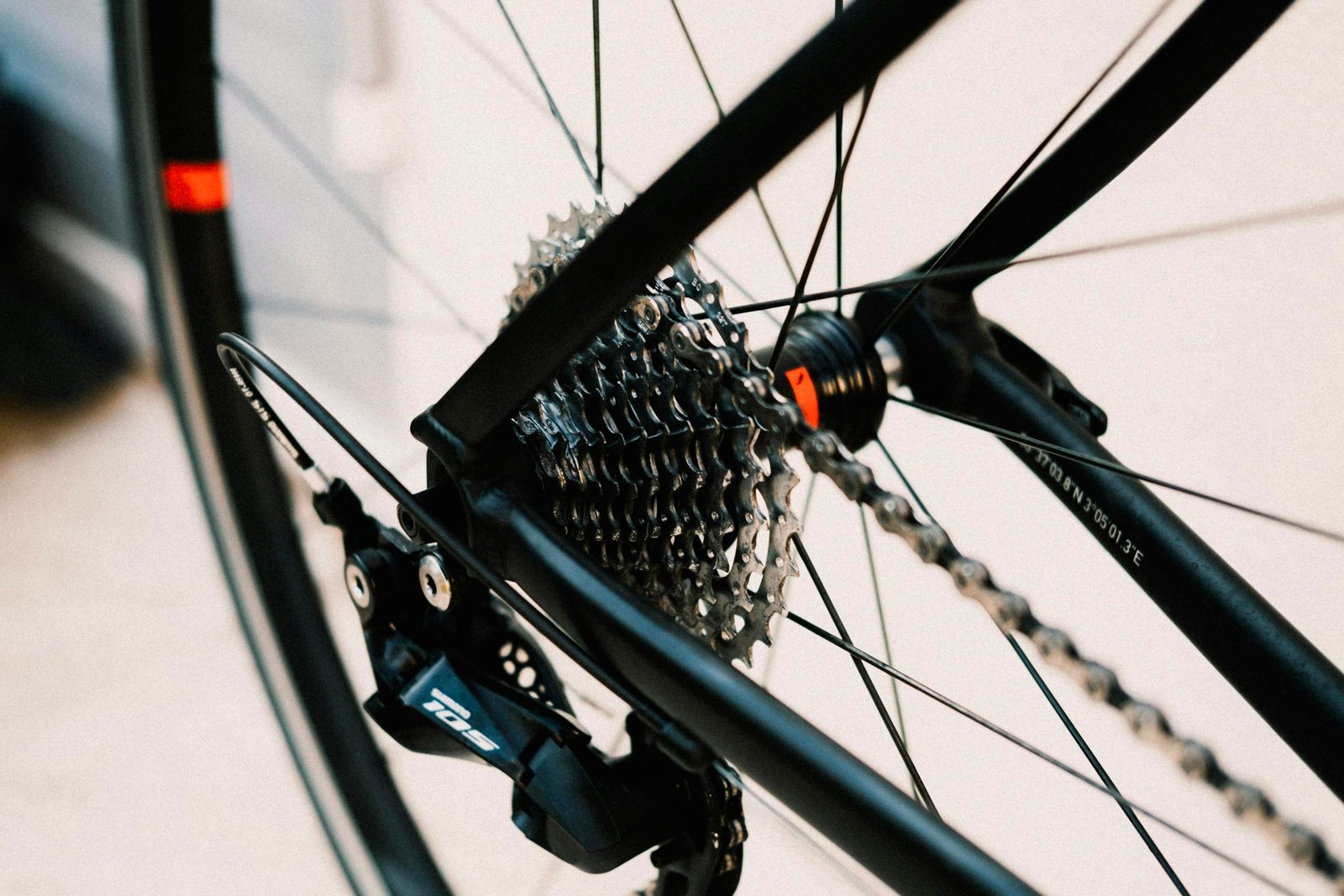Bicycle Chain Maintenance: 2025 How to Clean and Lube Guide
Your bicycle chain is the backbone of your riding experience, a critical component that can make or break your cycling performance! Imagine pedaling smoothly on a perfectly maintained bike, versus struggling with a neglected, grimy chain that creates squeaky noises and resistance.
Whether you’re a casual rider or a serious cyclist, mastering chain maintenance is your ticket to smoother, more enjoyable rides.
Understanding Bicycle Chain Maintenance: What No One Tells You
Bicycle chains are the backbones of cycling – nobody talks about them until something goes wrong. Trust me, I learned this lesson the hard way after a few beach trips and riding on the sand.
The Chain’s Hidden Complexity
A bicycle chain isn’t just a simple metal loop. It’s a precision-engineered piece of cycling technology consisting of inner and outer plates, pins, and rollers. Each link is designed to mesh perfectly with your bike’s cassette and chain-rings.
How Chains Actually Wear Down
Every pedal stroke creates microscopic wear. Dirt, grit, and improper lubrication accelerate this process faster than most cyclists realize. I discovered that a chain’s lifespan isn’t just about miles ridden, but how well it’s maintained.
Spotting Chain Deterioration
Early warning signs include weird clicking sounds, skipping gears, and increased resistance while pedaling. I learned to do a simple “pull test” – if a chain pulls away from the chain-ring more than a few millimeters, it’s time for replacement.
Maintenance: Your Chain’s Best Friend
Regular cleaning and lubrication can dramatically extend a chain’s life. I developed a simple routine: after muddy or dusty rides, I’d thoroughly clean the chain with a degreaser, then apply a high-quality bicycle-specific lubricant.

Thin, even layers beat glob applications every time. Don’t forget to wipe up any excess.
Chain Types Matter
Not all chains are created equal. Road bikes, mountain bikes, and urban commuters use different chain specifications. My mountain bike chain is wider and more robust compared to my road bike’s lightweight, narrow chain.
Remember, a well-maintained chain saves you money and improves your overall cycling experience.
Essential Tools for Chain Maintenance
Cleaning Essentials
Every serious cyclist needs a good degreaser. I swear by White Lightning Chain Degreaser – it cuts through grime without destroying your drivetrain. Pair it with some Park Tool brushes, and you’re golden.

Hold on to those old toothbrushes they work in a pinch, but dedicated bike brushes make a huge difference.
Lubrication Game-Changers
Not all lubes are created equal. For dry conditions, you can use Finish Line Dry Lube. When it’s wet or muddy, Muc-Off Wet Lube is your friend. These are just recommendations. There are many others that will work just fine. Do your research.
Chain Cleaning Devices
The Pedro’s Chain Pig is awesome for lazy maintenance folks. It’s a closed system that cleans your chain without making a massive mess.
For budget riders, a simple chain cleaning tool like the Muc-Off X-3 Dirty Chain Machine does wonders.
Wear Measurement Precision
Chain wear tools are critical. The Park Tool CC-3.2 Chain Checker is my absolute favorite. It tells you exactly when to replace your chain before you destroy your entire drivetrain. Trust me, a $20 tool can save you hundreds in replacement costs.
Protective Gear Matters
Get some nitrile gloves and old clothes. Chain maintenance is messy business. I learned this after ruining several nice jeans with grease stains that never came out.
Budget vs. Professional Kits
For beginners, the Pedros Bicycle Maintenance Kit is perfect. Around $50, it includes most tools you’ll need. Professionals might opt for more comprehensive Park Tool kits, but don’t feel pressured to drop $300 on tools right away.
Consistent, simple maintenance beats sporadic deep cleans every time.
Step-by-Step Chain Cleaning Process
Setting Up Your Cleaning Station
First things first – workspace matters. I spread out an old towel, gather my tools, and wear clothes I don’t mind destroying. Work in a well-ventilated area. Degreasers can be potent, and you don’t want to risk the chance of inhaling anything your lungs will thank you.
Chain Removal: When Deep Cleaning Calls
For thorough cleaning, removing the chain is best. The SRAM PowerLink makes this super easy – no special tools required. Just squeeze and separate. If you’re nervous, take a phone photo of your drivetrain first as a reference.
Degreasing Like a Pro
Citrus-based degreasers are my preference. Park Tool’s Citrus Degreaser cuts through grime without destroying your chain’s finish. Apply sparingly – more isn’t always better. Use a dedicated chain cleaning tool or an old toothbrush for detailed work.

Cleaning Techniques for Every Condition
Dry, dusty rides need different treatment than muddy adventures. For light dirt, a quick wipe-down works. For serious grime, I’ll let the degreaser sit for a few minutes before scrubbing. Always work from the bottom of the chain upwards.
Drying and Prep Work
After cleaning, thoroughly dry your chain. Compressed air works great, but a clean rag does the job too. Moisture is a chain’s enemy – trust me, I’ve learned this the hard way.
Rookie Mistakes to Avoid
Don’t over-degrease. Don’t skip drying. Don’t re-lube a dirty chain.
Cleaning your chain doesn’t have to be a chore – it’s preventative maintenance that saves you money.

My Slippery Journey: Mastering Chain Lubrication
I used to think any oil would do for my bike chain. Huge mistake. Proper lubrication is an art form that can make or break your cycling performance.
Understanding Lubricant Types
White Lightning offers a killer range of lubricants. Their “Clean Ride” is a wax-based lube perfect for dry conditions, while “Epic Ride” handles wet and muddy environments. These aren’t just products – they’re performance boosters.
Wet vs. Dry Condition Strategies
Dry riding? White Lightning’s Clean Ride creates a waxy coating that repels dust and dirt. For wet, muddy conditions, Epic Ride provides a more robust protective layer.
Cleaning your chain doesn’t have to be a chore – it’s preventative maintenance that saves you money.

Application Is Everything
Less is more with chain lube. I apply a single drop to each roller, then slowly backpedal to distribute evenly. Wipe off excess – those drips attract more dirt than they help.
Always clean your chain before lubrication for maximum effectiveness.
Lubrication Frequency
For casual riders, lubricate every 100-150 miles. Serious cyclists might need weekly application. Listen to your bike – grinding sounds mean it’s time to lube. Always lubricate after beach riding or riding in wet conditions.
Understanding Chain Wear and Replacement
Measuring Chain Wear Precisely
Chain wear happens gradually. My go-to tool is the Park Tool CC-3.2 Chain Checker. It measures chain stretch with incredible accuracy. Most chains start showing significant wear around 0.5-0.75% stretch. Don’t wait until it’s completely worn out.
The Real Cost of Procrastination
Delaying chain replacement can destroy your cassette and chainrings. I learned this the hard way – a $50 chain replacement turned into a $300 drivetrain overhaul. Those microscopic wear points add up quickly.
Measurement Tools Matter
Besides the Park Tool checker, digital micrometers provide super precise measurements. For budget cyclists, a ruler can work in a pinch – measure 12 complete links. If it’s longer than 12.1 inches, your chain is worn. Regular maintenance is always cheaper than replacement.
Preventative Maintenance Secrets
I’ve destroyed more bike chains through neglect than I care to admit. Each rusted, worn-out chain was a painful lesson in the importance of preventative maintenance. Now, I treat my chain like the critical component it is.
Creating a Maintenance Rhythm
Consistency is key. I developed a maintenance schedule that fits my riding style: quick wipe-downs after every ride, deep cleaning every 100-150 miles, and comprehensive checks at the start of each season. Think of it like changing the oil in your car – regular care prevents catastrophic failures.
Quick Cleaning Techniques for Busy Riders
Not everyone has hours to spend on bike maintenance. My go-to method? A microfiber cloth and quick degreaser spray after each ride. Spend just 5-10 minutes removing surface dirt and applying a light protective layer. It’s like dental flossing for your bike – quick but incredibly effective.
Storage: Your Chain’s Safe Haven
Where and how you store your bike matters more than most cyclists realize. Indoor storage prevents rust and environmental damage. I learned to hang my bike or use a stand that keeps the chain off the ground. Avoid damp basements, garages with temperature fluctuations, or outdoor exposure.
Weather-Proofing Strategies
Different conditions demand different protection approaches:
- Dry, dusty environments: Use wax-based lubricants that repel particles
- Wet, muddy conditions: Opt for wet-specific lubricants with stronger protective qualities
- Extreme temperatures: Choose lubricants designed for temperature stability
Seasonal Maintenance Considerations
Each season brings unique challenges:
- Spring: Deep clean after winter storage, check for any rust or degradation
- Summer: More frequent cleaning due to dust and increased riding
- Fall: Prepare for moisture and potential salt exposure
- Winter: Consider indoor training or protective storage methods

Comprehensive maintenance isn’t just about extending your chain’s life – it’s about ensuring consistent, reliable performance. Every minute spent on preventative care saves hours of potential repair time and prevents costly component replacements.

Environmental Factors to Watch
Your chain faces numerous invisible enemies:
- Salt from road treatments and ocean water
- Fine dust, sand and grit
- Humidity and temperature changes
- UV radiation
- Mechanical stress from different terrains
My Advanced Chain Care Masterclass
I realized chain maintenance is more science than art. What separates amateur cyclists from professionals isn’t just skill – it’s meticulous attention to equipment.
Professional-Level Techniques
Professional mechanics have secrets most riders never learn. They use ultrasonic cleaners that remove microscopic contaminants traditional cleaning can’t touch.
Precision matters – they measure chain wear to hundredths of a millimeter, not just visual inspection.
Rust: The Silent Performance Killer
Rust isn’t just cosmetic damage – it’s performance destruction. I’ve learned to immediately address any rust signs. White vinegar, specialized rust removers, and careful scrubbing can salvage a chain on the brink of replacement. Prevention always beats cure.
Discipline-Specific Maintenance
Different cycling disciplines demand unique approaches:
- Road cyclists need precision lubrication and minimal weight
- Mountain bikers require robust protection against mud and grit
- Touring cyclists prioritize long-term durability and consistent performance
Cutting-Edge Chain Care Technology
Ceramic coatings and advanced synthetic lubricants are super new. Brands like CeramicSpeed offer ultra-low friction treatments that can improve drivetrain efficiency by significant percentages. These aren’t just marketing claims – they’re measurable performance improvements.
Troubleshooting Common Issues
Most chain problems aren’t random – they’re predictable. Skipping gears usually indicates chain stretch. Unusual noise often means inadequate lubrication. I’ve learned to diagnose issues by sound, feel, and visual inspection.
Your chain is a complex mechanical system. Treat it with scientific precision, not just as a simple metal component.
Final Thoughts
Maintaining your bicycle chain isn’t just a chore—it’s an investment in your cycling experience. By dedicating a little time and effort to regular maintenance, you’ll enjoy smoother rides, improved performance, and significant long-term savings. Remember, a clean and well-lubricated chain is the foundation of a happy riding journey!
Engage, Endure and Enjoy!
Find More Resources on Bicycles
- Smart Bike Trainers: 2024 Best Picks with Features and Benefits
- Mountain Biking for Beginners: Essential Guide to Hit the Trails in 2024
- 3 Best Mountain Bikes of 2024: Complete Buyer’s Guide & Reviews
- How Do You Adjust Bike Brakes? A Step-by-Step Guide for 2024
- Essential Mountain Bike Gear: A Complete Guide for 2024







